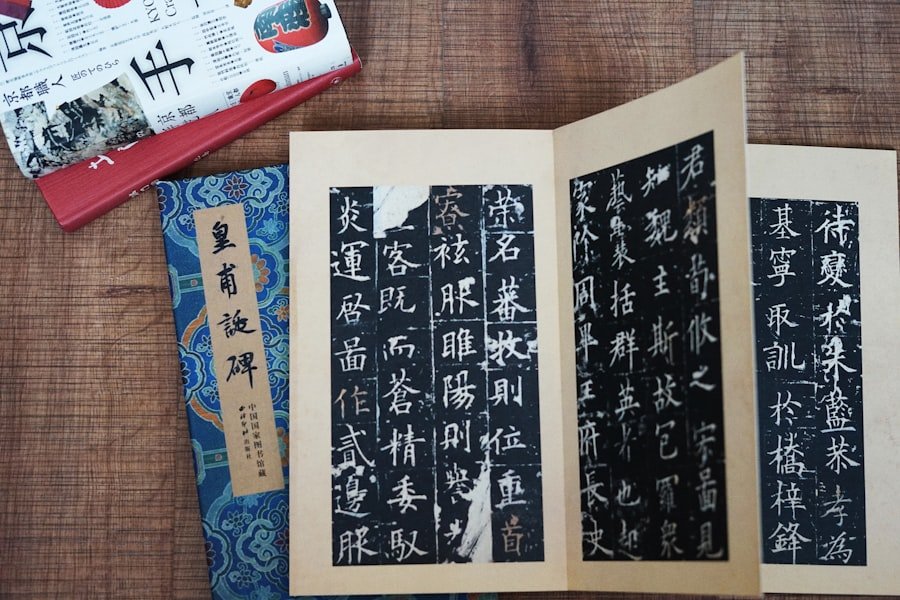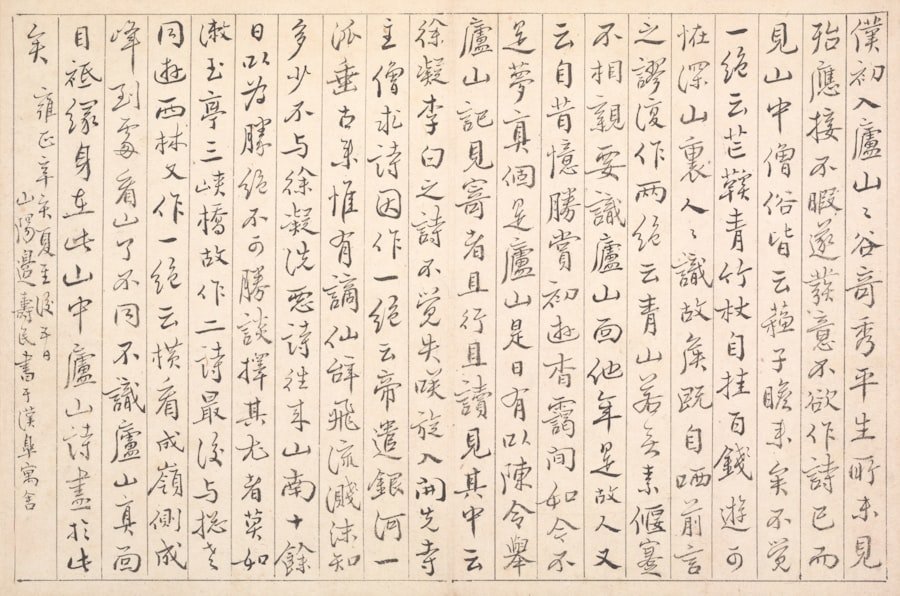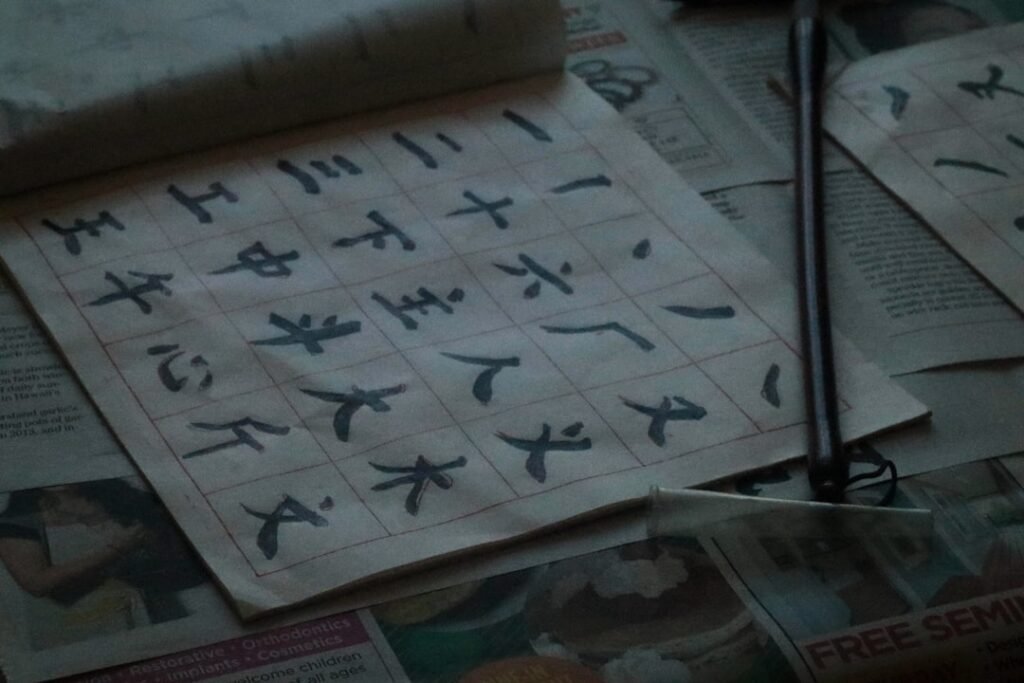Chinese calligraphy is not merely a form of writing; it is an intricate art that embodies centuries of cultural heritage and philosophical depth. Each stroke of the brush is a testament to the calligrapher’s skill, patience, and understanding of the characters they inscribe. Unlike the hurried scribbles of modern writing, Chinese calligraphy demands a slow and deliberate approach, where every movement is intentional and every character is a reflection of the artist’s inner state.
This meticulous process transforms the act of writing into a meditative practice, allowing the calligrapher to connect with their thoughts and emotions on a profound level. The beauty of Chinese calligraphy lies in its ability to convey meaning beyond mere words. Each character is imbued with history and significance, and the way it is rendered can evoke a range of emotions.
The fluidity of the brush strokes, the balance of space, and the harmony of composition all contribute to the overall aesthetic experience. As one engages in this art form, they are not just creating letters; they are crafting a visual poem that speaks to the heart and soul. This slow, deliberate craft invites practitioners to immerse themselves fully in the moment, fostering a deep appreciation for both the art and the culture from which it originates. Master the art of Chinese calligraphy. Enroll now at the LC Chinese School in Oslo.
Table of Contents
ToggleSummary
- Chinese calligraphy is a slow and deliberate craft, requiring patience and mindfulness.
- The philosophy of slowing down is central to the Chinese calligrapher’s approach, emphasising the value of taking time and embracing stillness.
- Calligraphers embrace simplicity and tradition in their tools, finding beauty in the handcrafted and imperfection.
- The practice of calligraphy offers lessons in patience, mindfulness, and finding balance in a busy world.
- Embracing imperfection and connecting with tradition are key aspects of honouring the legacy of Chinese calligraphy.
The Philosophy of Slowing Down: Understanding the Chinese Calligrapher’s Approach
At the core of Chinese calligraphy lies a philosophy that champions the importance of slowing down. In a world that often prioritises speed and efficiency, the calligrapher’s approach serves as a gentle reminder of the value of patience and contemplation. This philosophy encourages individuals to take a step back from their fast-paced lives and engage in a practice that nurtures mindfulness.
By focusing on each stroke and allowing oneself to be present in the moment, calligraphers cultivate a sense of tranquillity that can be elusive in everyday life. The act of writing in this traditional manner becomes a form of meditation, where the mind can quieten and the spirit can find solace. As calligraphers immerse themselves in their craft, they learn to appreciate the subtleties of each stroke, recognising that beauty often lies in the details.
This philosophy extends beyond the art itself; it permeates daily life, encouraging individuals to approach challenges with a sense of calm and deliberation. In embracing this slower pace, one can find clarity amidst chaos, fostering a deeper connection with both themselves and their surroundings.
The Calligrapher’s Tools: Embracing Simplicity and Tradition

The tools of a calligrapher are as essential to the art form as the techniques employed. Traditionally, these tools consist of four primary items: the brush, ink, inkstone, and paper. Each tool carries its own significance and requires careful selection and maintenance.
The brush, for instance, is crafted from animal hair and comes in various shapes and sizes, allowing for different styles and effects. The ink, made from natural materials, must be ground on an inkstone to achieve the desired consistency. This ritualistic preparation not only enhances the quality of the work but also deepens the calligrapher’s connection to their craft.
Embracing simplicity in these tools reflects a broader philosophy within Chinese culture that values minimalism and functionality. The calligrapher’s workspace is often uncluttered, allowing for focus and clarity during the creative process. This simplicity extends to the characters themselves; each stroke is purposeful, devoid of unnecessary embellishments.
By honing their skills with these traditional tools, calligraphers honour centuries of practice while also fostering a sense of respect for their craft. This connection to tradition enriches their work, imbuing it with layers of meaning that resonate with both the artist and the observer.
Cultivating Patience and Mindfulness: Lessons from the Calligrapher’s Table
The calligrapher’s table serves as a sanctuary for creativity, where patience and mindfulness are cultivated through practice. As one sits down to write, they enter a space that encourages reflection and introspection. The act of preparing the tools, mixing ink, and selecting paper becomes a ritual that sets the tone for what is to come.
Each moment spent at the table is an opportunity to embrace stillness and focus on the task at hand. This environment fosters an awareness of one’s thoughts and feelings, allowing for a deeper exploration of self. Through consistent practice at the calligrapher’s table, individuals learn that mastery comes not from haste but from dedication and perseverance.
Each character written is an opportunity for growth; mistakes are not seen as failures but as valuable lessons that contribute to one’s development as an artist. This mindset nurtures resilience and encourages individuals to approach challenges with grace. As they cultivate patience through their art, they also learn to apply these lessons to other aspects of their lives, fostering a sense of balance and harmony.
The Power of Silence: Finding Stillness in a Busy World
In an age characterised by constant noise and distraction, the power of silence becomes increasingly significant. Chinese calligraphy offers a refuge from this chaos, inviting practitioners to embrace moments of stillness as they engage with their art. The quietude that envelops a calligrapher as they focus on their brush strokes allows for introspection and contemplation.
In this silence, one can hear their thoughts more clearly, fostering a deeper understanding of themselves and their surroundings. This practice of finding stillness is not limited to the act of writing; it extends into daily life as well. By incorporating moments of silence into one’s routine—whether through meditation, reflection, or simply pausing to breathe—individuals can cultivate a sense of peace amidst external turmoil.
The lessons learned from Chinese calligraphy serve as a reminder that silence is not merely an absence of sound but a powerful tool for self-discovery and growth. In embracing this stillness, one can navigate life’s challenges with greater clarity and purpose.
Embracing Imperfection: The Beauty of Handcrafted Art

One of the most profound lessons imparted by Chinese calligraphy is the acceptance of imperfection. Each brushstroke carries with it the potential for error; however, it is within these imperfections that true beauty often resides. The unique character of each piece reflects not only the skill of the artist but also their individuality and emotional state at that moment in time.
This embrace of imperfection challenges contemporary notions of perfectionism, encouraging artists to celebrate their unique expressions rather than striving for unattainable ideals. In recognising that flaws can enhance rather than detract from a work’s beauty, calligraphers cultivate a sense of authenticity in their art. This perspective extends beyond calligraphy; it encourages individuals to embrace their own imperfections in life.
By acknowledging that mistakes are part of the journey, one can foster resilience and self-acceptance. This shift in mindset allows for greater creativity and freedom in expression, ultimately leading to more meaningful connections with oneself and others.
Connecting with Tradition: Honouring the Legacy of Chinese Calligraphy
Chinese calligraphy is steeped in tradition, serving as a bridge between past and present. Each character written carries with it centuries of history, embodying cultural values and philosophies that have shaped Chinese society. By engaging in this art form, practitioners honour not only their own heritage but also the generations of artists who have come before them.
This connection to tradition fosters a sense of belonging and continuity within an ever-changing world. The act of learning Chinese calligraphy is akin to stepping into a lineage that transcends time. As students immerse themselves in this practice at institutions like LC Chinese School in Oslo, they become part of a larger narrative that celebrates creativity and cultural expression.
Through workshops and classes focused on traditional techniques, students gain insight into the rich history behind each character they write. This connection to tradition not only enhances their artistic skills but also deepens their appreciation for the cultural significance embedded within each stroke.
Finding Balance: Navigating the Demands of Modern Life through Calligraphic Practice
In today’s fast-paced world, finding balance can often feel like an elusive goal. However, engaging in Chinese calligraphy offers a pathway towards achieving equilibrium amidst life’s demands. The slow and deliberate nature of this art form encourages individuals to carve out time for themselves—a necessary respite from daily pressures.
As practitioners immerse themselves in their craft, they discover that this dedicated time allows them to recharge mentally and emotionally. Through regular practice at places like LC Chinese School in Oslo, students learn to integrate moments of creativity into their busy lives. The discipline required for calligraphy fosters focus and clarity, enabling individuals to approach challenges with renewed energy and perspective.
By prioritising this artistic practice, one can cultivate resilience against stressors while also nurturing their creative spirit. Ultimately, Chinese calligraphy becomes not just an art form but a means of navigating modern life with grace.
The Role of Ritual: Creating Meaningful Moments in a Fast-Paced World
Rituals play an integral role in Chinese calligraphy, transforming each session into a meaningful experience rather than just another task on a checklist. From preparing tools to selecting ink and paper, every step becomes part of a larger ritual that imbues the practice with significance. These rituals create intentional moments where practitioners can pause, reflect, and connect with their art on a deeper level.
Incorporating ritual into daily life can help individuals cultivate mindfulness amidst chaos. By establishing routines—whether through morning meditation or evening calligraphy sessions—one can create sacred spaces that foster creativity and self-reflection. These rituals serve as anchors during turbulent times, reminding individuals to slow down and appreciate life’s simple pleasures.
As students at LC Chinese School engage in these practices together, they build community while honouring both tradition and personal expression.
Lessons in Adaptability: Embracing Change and Flexibility through Calligraphic Art
Chinese calligraphy teaches valuable lessons about adaptability—an essential skill in an ever-evolving world. As artists experiment with different styles or techniques within their practice, they learn to embrace change rather than resist it. Each brushstroke presents an opportunity for exploration; even mistakes can lead to unexpected discoveries that enhance one’s artistic voice.
This adaptability extends beyond art; it encourages individuals to approach life with flexibility and openness. By recognising that change is inevitable—and often beneficial—one can navigate challenges with greater ease. The lessons learned through calligraphy empower practitioners to embrace uncertainty while remaining grounded in their creative pursuits.
At LC Chinese School in Oslo, students are encouraged not only to develop technical skills but also to cultivate resilience through their artistic journey.
The Calligrapher’s Legacy: Passing Down Wisdom and Tradition in a Fast World
As we navigate an increasingly fast-paced world dominated by technology and instant gratification, preserving traditional arts like Chinese calligraphy becomes paramount. The legacy of calligraphers lies not only in their beautiful works but also in the wisdom they impart through teaching future generations. Institutions such as LC Chinese School play a vital role in ensuring that this rich cultural heritage continues to thrive.
By offering courses focused on traditional techniques alongside contemporary interpretations, LC Chinese School fosters an environment where students can explore their creativity while honouring tradition. Through mentorship from experienced instructors who understand both the technical aspects and philosophical underpinnings of calligraphy, students gain invaluable insights into this timeless art form. As they learn to wield their brushes with intention—imbuing each character with meaning—they become custodians of a legacy that transcends time.
In conclusion, engaging with Chinese calligraphy offers profound insights into patience, mindfulness, adaptability, and tradition—all essential qualities for navigating modern life successfully. Through dedicated practice at institutions like LC Chinese School in Oslo, individuals can connect deeply with this ancient art form while honouring its rich cultural heritage—a legacy worth preserving for generations to come.
Master the art of Chinese calligraphy. Enroll now at the LC Chinese School in Oslo.







